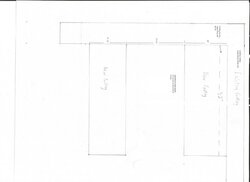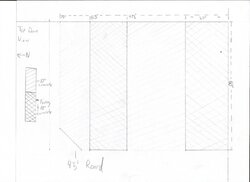So I guess I should first say hello. I am a Kansan whom is ready for a little better heat around the house and I have a few ideas on how I am going to go about it.
Firstly, my ideas on how to build my hearth are based on the idea that "radiant heat is king in the land of the cold" this is based on the fact that when I was a kid my dad and I(mainly my dad but I did as much as a 6 year old had in him!) built a hearth out of limestone that was equal to about 4 1/2 yards of rock. It was this area of rock that radiated heat throughout the house and kept it warm(even when a fire had long been out).
Now, I have lived in a cold --- double wide rental house, that was covered in tile floors and was fine w/ it and am now in a ranch style w/ a partial basement that is darn easy to keep warm compared to that ice house of a double wide. The house we are in is about 1700 sq ft up stairs w/ about a 400 sq ft partial. It could use a little more insulation in the attic which I plan on doing after I install a chimney, but other than that it is fairly well sealed (also needs some doors and storm doors but a mans gotta eat!! so a little at a time)
My plan is in a little off center of the house to build a hearth that is to be above the crawl space so in order to support all the rock that I plan to put in I am going to have to pour two, 1 cu. yd piers/supports with another 1 cu. yd concrete pad on top. My idea was to surround the piers that support the concrete pad w/ foam so as not to lose the heat into the ground and then between the piers and the pad put a layer of sand(yet still have them doweled in w/ rebar) to keep from putting as much heat in the crawl space(a bit of heat is good but a lot not so much as I like to keep the basement cooler for storage)
After this fun endeavor(because about 1 cu. yd of dirt will have to go out of the crawl space and that much concrete will have to come in ) I plan to build the part of the hearth you can see out of cut limestone to the tune of about 3.5 yards.
) I plan to build the part of the hearth you can see out of cut limestone to the tune of about 3.5 yards.
On top of that I am looking to set a Jotul F50 TL Rangeley (I've also thought about a PE T6 but I think its a little big and I may have already fallen for the Rangeley).
I am wondering, and this is where all the expertise here will really help, when I install the flue do I want to install a damper also?
The reason I ask is: normally I would not think that it would be needed in a single story house b/c I will probably have about 15' of pipe from the stove exhaust to the top. But, there are a bunch of things that make me think a may need it such as the constant sustained winds of over 15-20 mph and the fact that the chimney will be on the south side of the house where there are 3 different roof angles that meet within 10 feet of it. So this makes me worry that it may pull like a mad man. Also, I plan to install double wall up to the chimney for clearance reasons so I feel that may add to the excessive draft.
I know bla bla bla long post. Hopefully I didn't forget too much w/ this much here but I am trying to paint a decent picture.
Any ideas on top of what I have here are always appreciated so I'm all ears.
Thanks everyone
Eric
Firstly, my ideas on how to build my hearth are based on the idea that "radiant heat is king in the land of the cold" this is based on the fact that when I was a kid my dad and I(mainly my dad but I did as much as a 6 year old had in him!) built a hearth out of limestone that was equal to about 4 1/2 yards of rock. It was this area of rock that radiated heat throughout the house and kept it warm(even when a fire had long been out).
Now, I have lived in a cold --- double wide rental house, that was covered in tile floors and was fine w/ it and am now in a ranch style w/ a partial basement that is darn easy to keep warm compared to that ice house of a double wide. The house we are in is about 1700 sq ft up stairs w/ about a 400 sq ft partial. It could use a little more insulation in the attic which I plan on doing after I install a chimney, but other than that it is fairly well sealed (also needs some doors and storm doors but a mans gotta eat!! so a little at a time)
My plan is in a little off center of the house to build a hearth that is to be above the crawl space so in order to support all the rock that I plan to put in I am going to have to pour two, 1 cu. yd piers/supports with another 1 cu. yd concrete pad on top. My idea was to surround the piers that support the concrete pad w/ foam so as not to lose the heat into the ground and then between the piers and the pad put a layer of sand(yet still have them doweled in w/ rebar) to keep from putting as much heat in the crawl space(a bit of heat is good but a lot not so much as I like to keep the basement cooler for storage)
After this fun endeavor(because about 1 cu. yd of dirt will have to go out of the crawl space and that much concrete will have to come in
 ) I plan to build the part of the hearth you can see out of cut limestone to the tune of about 3.5 yards.
) I plan to build the part of the hearth you can see out of cut limestone to the tune of about 3.5 yards.On top of that I am looking to set a Jotul F50 TL Rangeley (I've also thought about a PE T6 but I think its a little big and I may have already fallen for the Rangeley).
I am wondering, and this is where all the expertise here will really help, when I install the flue do I want to install a damper also?
The reason I ask is: normally I would not think that it would be needed in a single story house b/c I will probably have about 15' of pipe from the stove exhaust to the top. But, there are a bunch of things that make me think a may need it such as the constant sustained winds of over 15-20 mph and the fact that the chimney will be on the south side of the house where there are 3 different roof angles that meet within 10 feet of it. So this makes me worry that it may pull like a mad man. Also, I plan to install double wall up to the chimney for clearance reasons so I feel that may add to the excessive draft.
I know bla bla bla long post. Hopefully I didn't forget too much w/ this much here but I am trying to paint a decent picture.
Any ideas on top of what I have here are always appreciated so I'm all ears.
Thanks everyone
Eric






